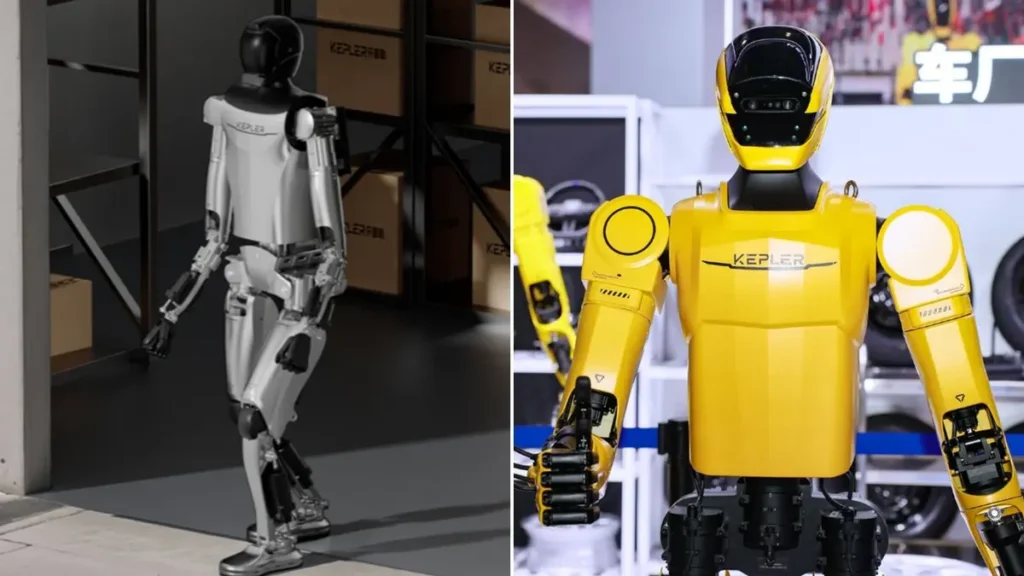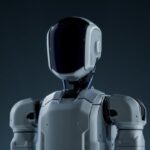
Kepler robotics/Linkedin
The robotics world is buzzing with excitement as China’s Kepler Robotics achieves a major breakthrough in humanoid locomotion. Their K2 “Bumblebee” humanoid robot has successfully mastered human-like straight-knee walking—a feat that represents one of the most significant advances in bipedal robotics in recent years.
The Engineering Marvel Behind Natural Gait
What makes Bumblebee’s achievement remarkable isn’t just that it can walk, but how it walks. The robot demonstrates a natural, human-like gait that eliminates the robotic “bent-knee shuffle” that has plagued humanoid robots for decades. This breakthrough stems from Kepler’s innovative hybrid actuator architecture that combines two distinct technologies in a sophisticated series-parallel configuration.
The Hybrid Actuator System:
- Planetary roller screw linear actuators: Provide precise linear motion and exceptional load-bearing capabilities
- Rotary actuators: Deliver rotational movement and dynamic control
- Series-parallel configuration: Enables seamless integration between both actuator types
This hybrid approach addresses the fundamental challenge in humanoid robotics: balancing precision, power, and energy efficiency while maintaining natural movement patterns.
Technical Innovation Meets Practical Application
Standing 175 cm tall and weighing 75 kilograms, Bumblebee packs impressive technical specifications. The robot features 52 degrees of freedom powered by over 80 integrated sensors, with onboard computing capabilities reaching 100 TOPS (trillion operations per second). This computational power enables real-time gait adaptation and autonomous decision-making.
The straight-knee walking capability isn’t just about aesthetics—it delivers tangible operational benefits:
Energy Efficiency: The natural gait pattern significantly reduces power consumption compared to traditional bent-knee walking algorithms, extending operational time and reducing energy costs.
Improved Stability: Straight-knee locomotion provides better balance and stability across varied terrains, crucial for industrial applications where robots must navigate complex environments.
Enhanced Task Execution: The more stable platform allows for better upper-body control during manipulation tasks, improving overall work performance.
AI-Driven Gait Control
Kepler’s breakthrough goes beyond hardware innovation. The company has developed sophisticated AI algorithms that enable Bumblebee to dynamically switch between different gait patterns based on terrain and task requirements. This adaptive capability combines:
- Reinforcement learning: Allows the robot to optimize its walking patterns through trial and experience
- Imitation learning: Enables the robot to learn from human movement demonstrations
- Linear actuator torque control: Provides precise force feedback for natural movement execution
Commercial Viability and Market Impact
Perhaps most significantly, Kepler has positioned Bumblebee as a commercially viable solution. Priced at $30,000 for the base model, the robot can reportedly perform the equivalent workload of 1.5 full-time human workers in comparable timeframes. This value proposition positions humanoid robots as legitimate alternatives for various industrial applications.
The robot has already demonstrated its capabilities in real-world scenarios, including automotive manufacturing facilities where it performs quality inspections and navigates complex factory environments. These practical deployments validate the technology’s readiness for commercial applications.
The Broader Impact on Robotics
Bumblebee’s straight-knee walking achievement represents more than a technical milestone—it signals a maturation of humanoid robotics technology. The successful integration of hybrid actuator systems with advanced AI control opens new possibilities for robots operating in human-designed environments.
This development positions Chinese robotics companies at the forefront of humanoid robot commercialization, potentially accelerating adoption across industries ranging from manufacturing and logistics to healthcare and service sectors.
Looking Forward
As Bumblebee continues to evolve, with recent upgrades including enhanced AI capabilities and improved industrial applications, it exemplifies the rapid progress in embodied AI. The combination of advanced hardware engineering, sophisticated control algorithms, and practical commercial focus suggests we’re entering a new era where humanoid robots transition from research curiosities to productive members of the workforce.
The success of Kepler’s hybrid actuator approach may influence the entire robotics industry, potentially establishing new standards for humanoid locomotion systems and accelerating the development of truly capable bipedal robots that can seamlessly integrate into human environments.





